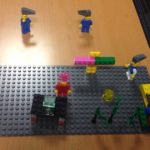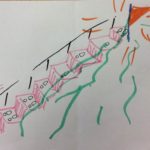Or, how can Lego help you to build a course or module?
Introduction to Programme Design is a one hour staff development session for new academic staff. The session covers key information that staff need to know about how programme and module design works at the University, including signposts to the frameworks and regulations and an overview of the support available.
To help staff start thinking about the complexity of course design, we gave them some lego and asked them to work in pairs to think about the elements that need to be considered, and how they relate to each other.
Why lego?
Why not? Lego is a simple to use, non-threatening tool that helps to externalise people’s ideas in a visual way. It provides a framework for storytelling, and as you will see from the results below, can help teams to synthesise and communicate big ideas. It’s used in many companies as part of a design thinking approach, to help find creative solutions to complex problems*.
Here are some of the elements that Lego helped us to discuss. Each team was given a standard set, along with a single ‘random’ piece. Click on the thumbnail images to view the full scenes:
This team used the lego to show the lecturer and students working within and co-creating a framework, which included other elements like NILE and QAP. The bridge between the students indicates social learning. The scene also includes ‘steps to success’ and a diving board to launch them into their career. The little eyes indicate institutional oversight, and the web is used to catch the students who are not engaged and enable them to ‘bounce’ back in to the course.
This scene has a student at the centre, as the course design starts from their expectations and needs. Alongside the student is an academic and a member of support staff, indicating working in partnership. The shark is about risk: in the form of competition from other universities, and of distractions from learning – the wall is a protection against this. The raised platform indicates student support, including academic standards, facilities like NILE and IT, and skills for employability.
Stakeholders in this scene include service users and commissioners, who are central to programme design for Health courses, as these must consider the needs of the local area in terms of health provision. Other elements include the resources available (lecturers, skills), and the constraints e.g. professional body regulations and quality frameworks. The elephant is Waterside, which will have a ‘massive’ influence on how we move forward with programme design.
The students in this depiction were widely scattered around the room, indicating the ‘geographically dispersed nature of learning communities’. They are connected by mobile devices. The staff member has a movable ‘office’ (which could be at home, a hotdesk, overseas etc). There are signposts for learners throughout the course. The purpose of the course is to help students achieve educational, career and social mobility, indicated by climbing the ladder.
In this scene, the students (on the left) arrive at different levels and some progress faster than others. The programme lead is looking towards them to help them progress. Ahead is the University management and governance, leading the direction of the University. The horse is University strategy, leaping obstacles and providing support to students. On the right is a platform – both for celebration of success (award ceremony) and as a launchpad to a career.
The exercise helped participants to start thinking about the stakeholders that need to be considered in programme design, the aims of their programme or module, and the ways that students are supported. The discussions showed the complexity of the course design process, and shaped our conversations about how it should be supported.
If you were in this session and would like to expand on your model, or if you weren’t but you’d like to respond to the models (or create your own!), please leave us a comment below.
To sign up for a session, visit the Staff Development organisation on NILE (note: you will need to be logged in to NILE for this link to work).
*Although we didn’t have time to use it in this session, the Lego Serious Play website outlines a full methodology for this approach.
Following my Getting ‘Waterside’ Ready post last week about ways in which the Learning Designers can help academic staff think about how to develop their skills for more blended learning and teaching, I thought it would be useful and fun(!) to share some of the drawings produced by one staff team on what they value in their face-to-face teaching. And I expect that not many of them ever thought they would see their artwork in print!
In light of the fact that it is the 100 year anniversary of Gallipoli, this tutor perceived his teaching in terms of going over the top and everyone being all in it together. No-one was left behind in the trench, but they were heading into no-man’s land and getting stuck in, entering the battle together.
 This image drew on the Greek idea of heaven. The various parts were all created and then everything was thrown up into the air and disrupted, before it all comes back down together as a composite whole.
This image drew on the Greek idea of heaven. The various parts were all created and then everything was thrown up into the air and disrupted, before it all comes back down together as a composite whole.
This image is about inspiration and asking questions, but that we are all on a different journey but will all end up reaching the horizon / sunset.
There are lots of different expressions on the people in this picture, showing apprension, anxiety, excitement, worry … As staff we have to manage so many different things that are going on for our students which is hard, but also exciting.
This picture is of climbing a mountain – there are hard challenges ahead, but our role is to give the students structured support to help them progress and ultimately to achieve their goal.
This image captures the role of the tutor as someone who can provide knowledge, students can find things out for themselves, we offer them support (a strong arm) and time.
As tutors we can generate excitement. This is a modern lightbulb representing new ideas and students bringing their own ideas and capabilities. A new generation of ideas and lots of sparks going off, all around.
 The idea of a teaching cycle is clearly apparent from this visual representation of what is valued in teaching. The notion of planting the seeds and nurturing the young plants as they grow into a mature tree that bears fruit in due time. Sometimes more seeds are needed but always the cycle continues.
The idea of a teaching cycle is clearly apparent from this visual representation of what is valued in teaching. The notion of planting the seeds and nurturing the young plants as they grow into a mature tree that bears fruit in due time. Sometimes more seeds are needed but always the cycle continues.
Mature students can also be anxious about learning, but as they share their experiences this can lead to illumination and qualification.
This tutor conceived of his face-to-fae teaching as including lots of talking in a safe and secure environment where they can flourish and develop themselves. Drama and other physical activities take place both in and out of the classroom and the role of the tutor is to take that step back and watch the students flourish.
The notions about teaching in this image are that of encouraging the students to think differently and independently – they may well end up on a different route to that envisaged by the tutor. Includes the idea of being a rebel.
A number of ideas are expressed here – the notion of signposting students, mountains to climb and holding up a mirror to the students to get them to reflect and learn from themselves and others – they are their own resource.
This final image also captures a variety of concepts. There is the idea of dialogue leading to lightbulb moments both as students among themselves but also in discussions with tutors. They are also the drivers, the ones in control, but it isn’t a ‘journey’ – this tutor wants students to be bothered and to be rebels WITH a cause.
Q: How do you eat an elephant?
A: One bite at a time!
 The move to Waterside can seem as if it isn’t really that long away, given all that you may feel you have to do inbetween now and then. Wondering where to start can also seem daunting and the mountain of work that you see ahead of you can be so huge that you can’t even see the summit, let alone work out a route to the top.
The move to Waterside can seem as if it isn’t really that long away, given all that you may feel you have to do inbetween now and then. Wondering where to start can also seem daunting and the mountain of work that you see ahead of you can be so huge that you can’t even see the summit, let alone work out a route to the top.
In supporting staff to get to grips with the course redesign implications that are predicated on a number of guiding principles about how learning and teaching will look, the Learning Design team came across a really useful set of blog posts by Tony Bates, a Canadian Research Associate who is also President and CEO of Tony Bates Associates Ltd and who, according to their website are “a private company specializing in consultancy and training in the planning and management of e-learning and distance education.”
The blog posts were written to help people understand and implement a series of practical steps to help deliver quality in their online learning materials. While I don’t wish to duplicate the posts here, I thought it might be helpful to summarise some of the key points in an attempt to help you to start thinking about how you might begin to eat your own elephant, or climb that mountain. I found some obvious points in the posts, some practical and straightforward suggestions and some real gems. There are also some questions and exercises to get you started along the road to redesigning your own modules.
I should also preface this post with the reminders that, as an institution, we are definitely NOT going fully online but will be exploring ways to enhance our learning and teaching using technology and that the precise nature of each blended module is for staff teams to determine.
The Nine Steps are as follows (each link will take you straight to the original post)
- Step 1: Decide how you want to teach online
- Step 2: Decide on what kind of online course
- Step 3: Work in a Team
- Step 4: Build on existing resources
- Step 5: Master the technology
- Step 6: Set appropriate learning goals
- Step 7: Design course structure and learning activities
- Step 8: Communicate, communicate, communicate
- Step 9: Evaluate and innovate
Step 1: Decide how you want to teach online
 This step highlights the importance of rethinking the way you teach when you go online and redesigning the teaching to meet the needs of your online learners given that their needs may differ because of the specific learning context. The gem in this post is the emphasis on asking you to consider your basic teaching philosophy – what is your role and how would you like to tackle some of the limitations of classroom teaching and renew your overall approach to teaching? As Bates himself says: “It may not mean doing everything online, but focussing the campus experience on what can only be done on campus.”
This step highlights the importance of rethinking the way you teach when you go online and redesigning the teaching to meet the needs of your online learners given that their needs may differ because of the specific learning context. The gem in this post is the emphasis on asking you to consider your basic teaching philosophy – what is your role and how would you like to tackle some of the limitations of classroom teaching and renew your overall approach to teaching? As Bates himself says: “It may not mean doing everything online, but focussing the campus experience on what can only be done on campus.”
Step 2: Decide on what kind of online course
 Bates describes a continuum of online learning ranging from online classroom aids to fully online and explores four key factors that will influence the kind of online course you should be teaching:
Bates describes a continuum of online learning ranging from online classroom aids to fully online and explores four key factors that will influence the kind of online course you should be teaching:
- your teaching philosophy (see step 1)
- the kind of students you are trying to reach (or will have to teach)
- the requirements of the subject discipline
- the resources available to you
A number of subject groups and disciplines are already starting to explore what the current direction of travel for learning and teaching at Northampton might look like for them and developing models and suggestions for how to redesign their modules and programmes within a broader set of principles. It is useful to note that while Bates experience suggests that “almost anything can be effectively taught online, given enough time and money” (emphasis added), the reality is that resources are finite and that it is therefore imperative to work out what could and should be taught face-to-face and what could and should be taught online, remembering that we are still going to be primarily a campus-based institution. He begins the process by differentiating between the teaching of content and the teaching or development of skills and provides a useful example of how this might look in practice.
The gem here is his consideration of how to make best use of the various resources available to you including time (the most precious resource of all), your learning technology support staff (always glad to help), your VLE (NILE) and your colleagues.
Step 3: Work in a Team
 Online learning is different to classroom teaching and as a result will require staff to learn some new skills. You are unlikely to have all your F2F learning materials in a suitable format for online learning. This post considers how the team of staff around you can help you to move from where you are, to where you want to get to given that “particular attention has to be paid to providing appropriate online activities for students, and to structuring content in ways that facilitate learning in an asynchronous online environment”. Working in a team can also, of course, help with managing the workload, and with getting quickly to a high quality online standard, as well as being a way to save some of your time.
Online learning is different to classroom teaching and as a result will require staff to learn some new skills. You are unlikely to have all your F2F learning materials in a suitable format for online learning. This post considers how the team of staff around you can help you to move from where you are, to where you want to get to given that “particular attention has to be paid to providing appropriate online activities for students, and to structuring content in ways that facilitate learning in an asynchronous online environment”. Working in a team can also, of course, help with managing the workload, and with getting quickly to a high quality online standard, as well as being a way to save some of your time.
Step 4: Build on Existing Resources
As one Deputy Dean said at a recent School Learning and Teaching Development Day: “Let’s not throw the baby out with the bathwater!”
This can include repurposing your own content, but also drawing on existing online resources (TED talks, The Khan Academy, iTunesU) as well as ‘raw’ content that you can use as the basis for developing learning activities and he argues that ‘only in the areas where you have unique, original research that is not yet published, or where you have your own ‘spin’ on content, is it really necessary to create ‘content’ from scratch”.
The hidden gem? Distinguishing between using existing resources that “do not transfer well to an online learning environment (such as a 50 minute recorded lecture), and using materials already specifically developed for online teaching”. He suggests that you “take the time to be properly training in how to use [NILE]”, recognising that a 2-hour investment now can save you hours of time later on.
Step 5: Master the Technology

That’s it really – come to some training on the tools that you would like to use and know more about! This includes learning about their strengths and weaknesses so that you know that you have selected the right tool for the job, but also have a clearer idea about how they might work in practice or how to avoid some of the pitfalls. There are plenty of tools out there, but selecting the right tool is an instructional or pedagogical issue that requires you to be clear on what it is that you are trying to achieve.
Bates’ gem (from my perspective) is his no-nonsense approach to engaging with central training and development initiatives. Here are a few that might help:
- The CLEO (Collaborative Learning Experiences Online) workshop that forms part of our C@N-DO staff development programme is a good way of putting yourself in the shoes of the online learning and experiencing first hand some of the obstacles that online learners face, in order to prevent your own students facing similar issues.
- NILE training (around specific pedagogical purposes) is provided by the Learning Technology team and in addition to regular scheduled training, can also be tailored to suit the purposes of your subject team or discipline. Please just ask!
- Spend a little time each year looking at any of the new features added to NILE during the year (Check out the Learntech Blog for updates).
Finally in this step is a discussion around why simply recording your lectures is not the best way to go. Definitely worth the time to read through his reasons, if this is something you were considering.
Step 6: Set appropriate Learning Goals
 In short, should the learning goals (outcomes) for online/blended learning be the same as, or different to the same module delivered in a fully face-to-face mode? The key differentiator is that while the goals may well remain the same, the method may change. He also raises the question as to whether additional learning outcomes need to be considered in terms of the development of 21st century learning skills (in particular, learning the skills to ‘manage knowledge’ long after they graduate).
In short, should the learning goals (outcomes) for online/blended learning be the same as, or different to the same module delivered in a fully face-to-face mode? The key differentiator is that while the goals may well remain the same, the method may change. He also raises the question as to whether additional learning outcomes need to be considered in terms of the development of 21st century learning skills (in particular, learning the skills to ‘manage knowledge’ long after they graduate).
The link between learning outcomes and assessment is also explored here as is the way in which assessment drives student behaviour. He concludes by saying that “[b]ecause the internet is such a large force in our lives, we need to be sure that we are making the most of its potential in our teaching, even if that means changing somewhat what and how we teach”.
Step 7: Design Course Structure and Learning Activities
After an initial exploration between ‘strong’ and ‘loose’ online learning structures, Bates identifies the three main determinates of teaching structure as being:
- the organisational requirements of the institution;
- the preferred philosophy of teaching of the instructor; and
- the instructor’s perception of the needs of the students.
In the light of recent discussions here around what is meant by ‘contact’ hours (see this Definitions paper produced recently by the University’s Institute of Learning and Teaching), he identifies problems with this approach whilst simultaneously recognising that this is, nevertheless, the standard measuring unit for face-to-face teaching. One reason he highlights in particular is that it measures input, not output. Bates is also keen to ensure parity between online and face-to-face learning in terms of ensuring quality at Validation.
He discusses the time input as well as the structure of modules and how existing face-to-face structures mean we can already be some way down the path on module design, with the important proviso that it is important to ensure that content moved online is suitable for online learning. This is where the Learning Design team can help you to make decisions around what to teach or what to leave out, given that making some work optional means it should not be assessed and that if it is not assessed, students will quickly learn to avoid doing it.
This step concludes with a look at how to design student activities. This is typically something that would be covered during the second day of a CAIeRO curriculum redesign workshop, but anyone who has participated in any part of the C@N-DO programme will already have come into contact with some of these online learning activities / e-tivities. Some good points for consideration here though.
Step 8: Communicate, communicate, communicate
 This steps explores the vital importance of ongoing, continuing communication between the tutor and the online learners, that is more than simply seeing them in class on a weekly basis. Maintaining tutor presence in the online environment is a “critical factor for online student success and satisfaction”, helping students recognise that their online contributions are just as much a part of their learning experience as the face-to-face components.
This steps explores the vital importance of ongoing, continuing communication between the tutor and the online learners, that is more than simply seeing them in class on a weekly basis. Maintaining tutor presence in the online environment is a “critical factor for online student success and satisfaction”, helping students recognise that their online contributions are just as much a part of their learning experience as the face-to-face components.
Creating a compelling online learning environment is possible but requires deliberate planning and conscientious design. It must also be done in such a way as to control the instructor’s workload. Bates has a number of ‘top tips’ for setting and managing student expectations online and emphasises that tutors should also adhere to these themselves. Like in the CLEO, he suggests starting with a small task in the first week that enables the guidelines to be applied, with the tutor paying particular attention to this activity. As he rightly points out …
students who do not respond to set activities in the first week are at high risk of non-completion. I always follow up with a phone call or e-mail to non-respondents in this first week, and ensure that each student is following the guidelines … What I’m doing is making my presence felt. Students know that I am following what they do from the outset.
There is a discussion here around the benefits and disadvantages of both synchronous and asynchronous communication – the decision again being based on pedagogical need. There is also a list of tips for how to manage online discussions for you to read an inwardly digest 🙂 and a consideration of how cultural factors can impact on participation.
Step 9: Evaluate and Innovate
 We ask our students to do it all the time – let’s make sure we apply the same principles to our own learning and teaching development and complete our own reflective cycle. Bates has a series of questions to guide any evaluation of teaching (not just online teaching), linking it back to Step 1 where he defines what we mean in terms of ‘quality’ in online learning. This doesn’t have to be a hugely onerous task – we already have ways of answering some of the questions (e.g. student grades, student participation rates in online activities (track number of views), assignments, Evasys questionnaires etc).
We ask our students to do it all the time – let’s make sure we apply the same principles to our own learning and teaching development and complete our own reflective cycle. Bates has a series of questions to guide any evaluation of teaching (not just online teaching), linking it back to Step 1 where he defines what we mean in terms of ‘quality’ in online learning. This doesn’t have to be a hugely onerous task – we already have ways of answering some of the questions (e.g. student grades, student participation rates in online activities (track number of views), assignments, Evasys questionnaires etc).
Then consider what it is that you need to do differently next time, in this ongoing, iterative process of Quality Enhancement.
Hopefully you will have the opportunity to explore some of these blog postings as you begin to think about how to get ready for Waterside, even if you don’t agree with everything that Bates says!
Recent Posts
- H5P (HTML5 package) content types meets the needs of Jim Atkinson, Staff Development Trainer
- Blackboard Upgrade – July 2025
- StudySmart 2 – Student Posters
- NILE Ultra Course Award Winners 2025
- Blackboard Upgrade – June 2025
- Learning Technology / NILE Community Group
- Blackboard Upgrade – May 2025
- Blackboard Upgrade – April 2025
- NILE Ultra Course Awards 2025 – Nominations are open!
- Blackboard Upgrade – March 2025
Tags
ABL Practitioner Stories Academic Skills Accessibility Active Blended Learning (ABL) ADE AI Artificial Intelligence Assessment Design Assessment Tools Blackboard Blackboard Learn Blackboard Upgrade Blended Learning Blogs CAIeRO Collaborate Collaboration Distance Learning Feedback FHES Flipped Learning iNorthampton iPad Kaltura Learner Experience MALT Mobile Newsletter NILE NILE Ultra Outside the box Panopto Presentations Quality Reflection SHED Submitting and Grading Electronically (SaGE) Turnitin Ultra Ultra Upgrade Update Updates Video Waterside XerteArchives
Site Admin

















